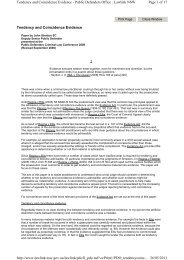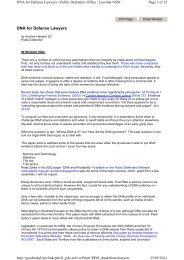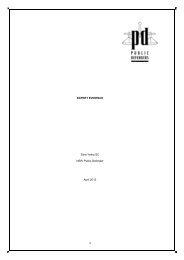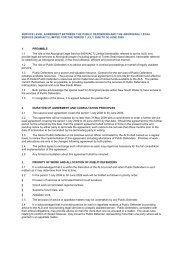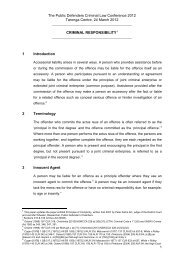Right to Silence: inferences from silence - The Public Defenders
Right to Silence: inferences from silence - The Public Defenders
Right to Silence: inferences from silence - The Public Defenders
Create successful ePaper yourself
Turn your PDF publications into a flip-book with our unique Google optimized e-Paper software.
‘Proper’ Inferences of Guilt<br />
Under s.35 CJPO 1994, the ‘proper’ <strong>inferences</strong> come about as a result of the failure of the<br />
accused <strong>to</strong> give evidence or his refusal without good cause <strong>to</strong> answer any question (s.<br />
35(3)).<br />
Defendants whose ‘physical or mental condition make it undesirable’ for them <strong>to</strong> give<br />
evidence are excluded <strong>from</strong> the operation of the section, <strong>to</strong>gether with those whose<br />
‘guilt is not in issue’ (s. 35(1)).<br />
By virtue of s. 35(5), the accused may be excused <strong>from</strong> answering a particular question on<br />
grounds of privilege or statu<strong>to</strong>ry entitlement, or in the discretion of the court. Subject <strong>to</strong> these<br />
exceptions, the accused must answer all proper questions or risk the drawing of <strong>inferences</strong>,<br />
and a judge may remind him of his duty in this regard, though he should avoid doing so in an<br />
oppressive way (Ackinclose [1996] Crim LR 747).<br />
<strong>The</strong> court is obliged <strong>to</strong> satisfy itself that defendants who have not indicated that they intend<br />
<strong>to</strong> give evidence understand the consequences of declining <strong>to</strong> do so (s. 35(2) and (3) and<br />
the Consolidated Criminal Practice Direction, para. IV.44, Defendant’s right <strong>to</strong> give or not <strong>to</strong><br />
give evidence). <strong>The</strong> Practice Direction makes clear that the burden of explaining the option<br />
<strong>to</strong> testify and the consequences of failing <strong>to</strong> do so <strong>to</strong> the defendant rests, in the case of a<br />
legally represented defendant, with the legal representative.<br />
Accused with Physical or Mental Limitations<br />
<strong>The</strong> meaning of s. 35(1)(b) of the CJPO 1994 was considered in Friend [1997] 1 WLR 1433.<br />
F was tried for murder. He had a physical age of 15, a mental age of 9, and an IQ of 63.<br />
Expert evidence suggested that, although not suggestible, his powers of<br />
comprehension were limited and he might find it difficult <strong>to</strong> do justice <strong>to</strong> himself in the<br />
witness box. Nevertheless F had given a clear account of his defence at various<br />
stages prior <strong>to</strong> trial. Taking all of these matters in<strong>to</strong> account, the trial judge ruled that<br />
F’s mental condition did not make it ‘undesirable’ for him <strong>to</strong> give evidence, so that his<br />
failure <strong>to</strong> do so led <strong>to</strong> the jury being directed that they might draw <strong>inferences</strong> under s.<br />
35(3). <strong>The</strong> Court of Appeal agreed, noting that it would only be in a rare case that the<br />
judge would be called upon <strong>to</strong> arrive at a decision under s. 35(1)(b); generally an accused<br />
who was unable <strong>to</strong> comprehend proceedings so as <strong>to</strong> make a proper defence would be unfit<br />
<strong>to</strong> plead, so the issue would not arise.<br />
Section 35(1)(b) was intended <strong>to</strong> mitigate any injustice <strong>to</strong> a person whose physical or mental<br />
handicap was less severe, and it gave a wide discretion <strong>to</strong> a trial judge which did not require<br />
<strong>to</strong> be circumscribed by any further judicial test.<br />
<strong>The</strong> trial judge had been right not <strong>to</strong> base his conclusion on the mental age of F: a person<br />
with a mental age of less than 14 did not au<strong>to</strong>matically qualify for the protection which before<br />
1998 applied <strong>to</strong> a person of that physical age. Nor was he bound <strong>to</strong> determine the issue on<br />
the expert evidence alone, but was entitled <strong>to</strong> take account of the behaviour of F before and<br />
after the commission of the offence including the way in which he had put his defence in<br />
interview. (<strong>The</strong> conduct of F at the time of the offence, which was hotly disputed, was rightly<br />
not considered by the judge.) <strong>The</strong> trial judge in Friend seems <strong>to</strong> have been much influenced<br />
by the fact that young children regularly appear as witnesses in criminal cases, and that<br />
measures can be taken by which they and other vulnerable witnesses can, if their needs are<br />
correctly assessed, be protected <strong>from</strong> unfair or oppressive cross-examination. Thus, as the<br />
main reason for questioning the desirability of F testifying was that he might give a poor<br />
account of himself unless care were taken <strong>to</strong> ensure that he unders<strong>to</strong>od and had time <strong>to</strong><br />
respond <strong>to</strong> questions, the fact that the court itself could respond sensitively <strong>to</strong> F’s needs was<br />
Colin Wells July 2013 Page 18



